Related Research Articles
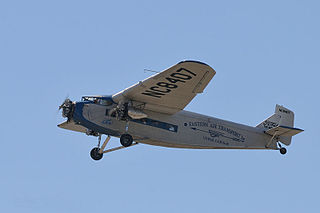
The Ford Trimotor is an American three-engined transport aircraft. Production started in 1925 by the companies of Henry Ford and ended on June 7, 1933. A total of 199 Ford Trimotors were made. It was designed for the civil aviation market, but also saw service with military units.
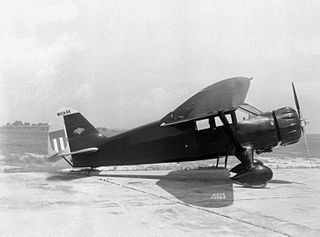
The Stinson Aircraft Company was an aircraft manufacturing company in the United States between the 1920s and the 1950s.

The Curtiss Robin, introduced in 1928, was a high-wing monoplane built by the Curtiss-Robertson Airplane Manufacturing Company. The J-1 version was flown by Wrongway Corrigan who crossed the Atlantic after being refused permission.

The Fokker F.VII, also known as the Fokker Trimotor, was an airliner produced in the 1920s by the Dutch aircraft manufacturer Fokker, Fokker's American subsidiary Atlantic Aircraft Corporation, and other companies under licence.
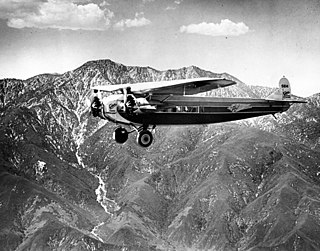
The Fokker F-10 was an enlarged development of the Fokker F.VII airliner, built in the late 1920s by the Fokker Aircraft Corporation of America. It carried 12 passengers, four more than the F.VII, and had a larger wing and more powerful engines.
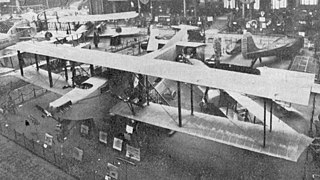
The Caudron C.61 was a French three-engined civil transport biplane aircraft built by the French aeroplane manufacturer Caudron. It was constructed of wood and covered in fabric.

The Caproni Ca.97 was a civil utility aircraft produced in Italy in the late 1920s and early 1930s. As originally designed, it was a high-wing braced trimotor monoplane of conventional configuration with one engine mounted on the nose and the other two carried on strut-mounted nacelles at the fuselage sides. Examples were also produced with only the nose engine or only the two nacelle-mounted engines.

The Vultee V-1 was a 1930s American single-engined airliner built by the Airplane Development Corporation, designed by Gerard Vultee and financed by automobile manufacturer Errett Cord.

The Saro Cloud was a British passenger amphibian flying boat designed and built by Saunders-Roe as the A.19. It was later produced as the A.29 for the Royal Air Force for pilot and navigator training.

The Fokker F.XIV was a cargo plane built in the Netherlands in the late 1920s by Fokker. It was a high-wing cantilever monoplane of conventional trimotor layout. The sole example was tested by KLM but never put into service.

The PZL.4 was a Polish three-engine passenger aircraft for 10 passengers, built in PZL factory in 1932, which remained a prototype. It was the first Polish-designed and produced multi-engine plane.

The Stinson SM-6000 Airliner was a 1930s three-engined (trimotor) ten-passenger airliner designed and built by the Stinson Aircraft Corporation. The SM-6000 was a high-wing braced monoplane with room for a pilot and a cabin for ten passengers. It was powered by three 215 hp (160 kW) Lycoming R-680 engines strut-mounted one each side above the main landing gear units and one in the nose. A number of variants were built mainly with improved interiors. In 1932 the Model U Airliner was produced which had low-set stub wings with an engine mounted at each wingtip.

The Stout 2-AT Pullman, or "Air Pullman", was a single engine all-metal monoplane that was used for early airline travel and air mail transport in America.
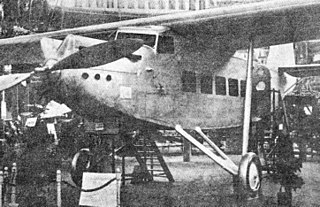
The Dewoitine D.30 was a ten-seat cantilever monoplane built in France in 1930. The D.30 was a single-engine aircraft but the second was completed as a trimotor and redesignated D.31.
The St. Louis C2 Cardinal family are a series of light sport monoplanes built by the St. Louis Aircraft Corporation during the peak of the Lindbergh Boom after the Spirit of St. Louis flight of 1927.
The Towle TA-2 was an amphibious aircraft based on the T owle WC built for a 1929 round-the world flight.

The Towle TA-3 was an amphibious aircraft based on the Towle TA-2.

The Eastman E-2 Sea Rover, also called the Beasley-Eastman E-2 Sea Rover, was a light seaplane built in the late 1920s for business and shuttle use.
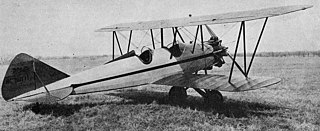
The Rearwin Ken-Royce was an American three-seat sport/touring biplane built by Rearwin Airplanes first in Salina, Kansas then Kansas City. It was the first airplane built by the company.

The Gee Bee Model A was an American two-seat open cockpit single-bay biplane developed by the Granville Brothers that first flew in 1929.
References
- 1 2 3 Robert F. Pauley (2009). Michigan Aircraft Manufacturers. Arcadia Publishing. p. 66. ISBN 9780738552187.
Fred Hise, a Detroit industrialist, saw a market for a small, high-quality tri-motor for business use.
- ↑ Aeroplane. April 2006.
{{cite journal}}: Missing or empty|title=(help) - ↑ "Hise Aircraft May Locate at Pontiac". Detroit Free Press. 25 August 1929. p. 64. Retrieved 31 October 2019– via Newspapers.com.
- ↑ Neville 1929 , pp. 502, 507
- 1 2 Orders and Opinions of the Michigan Public Service Commission. 1930. pp. 430–431.
- ↑ "Revoke Approval of Airline Stock". Lansing State Journal. 24 October 1930. Retrieved 31 October 2019– via Newspapers.com.
- ↑ "Explanation is Wanted". Battle Creek Enquirer. Battle Creek, Michigan. 2 May 1930. p. 24. Retrieved 31 October 2019– via Newspapers.com.
- ↑ Skyways. October 2001.
{{cite journal}}: Missing or empty|title=(help) - ↑ Neville 1929, p. 508
- Neville, Leslie E. (September 7, 1929). "Technical Aspects of the Cleveland Exposition" . Aviation . Vol. 27, no. 10. pp. 502–510. Retrieved October 31, 2019.